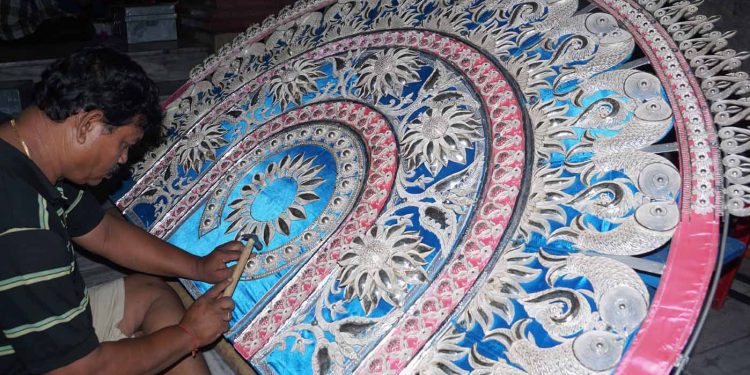Odisha observes as many as 13 major festivals every year, with Durga Puja being celebrated with much pomp. One of the major Durga Puja hubs in the state is Cuttack. With Durga Puja just around the corner, Cuttack will once again wear a festive look and attract millions over a period of five days to revel in the festivities.
As of 2019, official figures suggest that there are 165 puja committees in Cuttack that have been organising Durga Puja every year. While many are more than half a century old, the last decade has seen quite a few new entrants. Needless to say, the festival not only gives revellers plenty of opportunities to make the most of the festivities but also generates business for many.
Among them are the craftsmen who make silver filigree products. Cuttack, which is home to the delicate art of silver filigree, has witnessed a decline in the silver jewellery crafting industry. However, there are still quite a few filigree artisans who wait for Durga Puja when they get large orders. With the growing number of Durga Pujas in the state, filigree artisans do good business at this time of year.
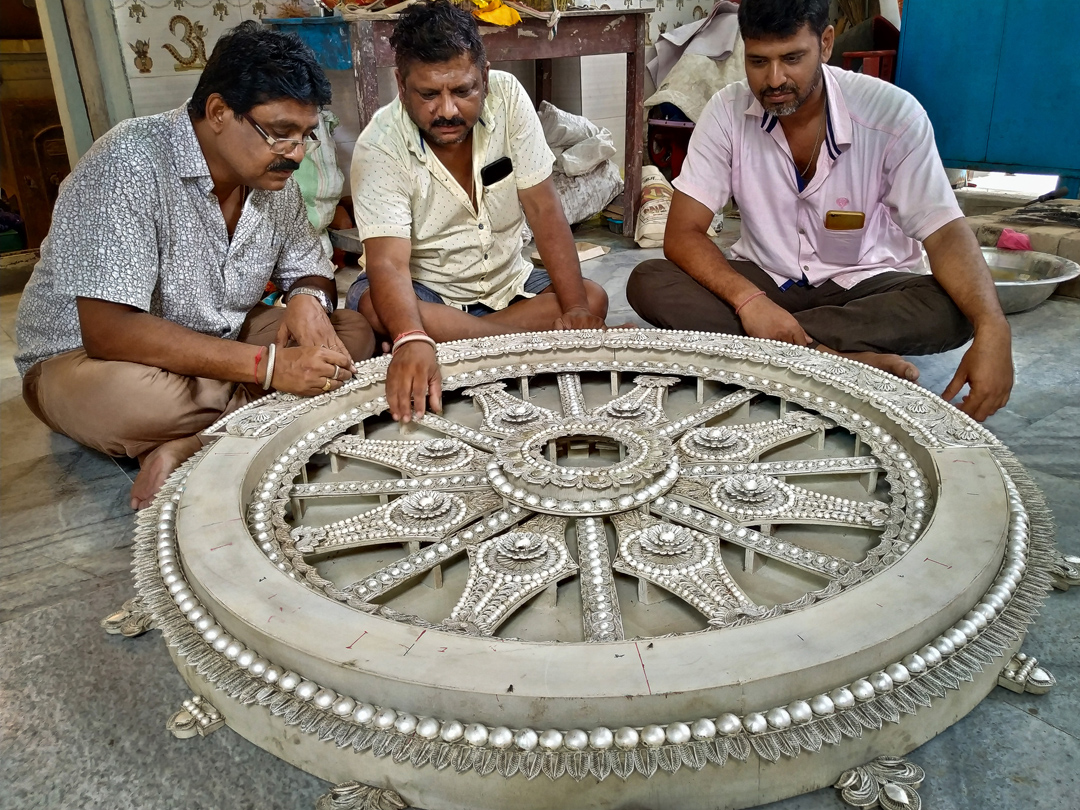
Moreover, the silver filigree backdrop (chandi medhas) that had gone out of fashion a few years ago is making a comeback. This certainly is a ray of hope for filigree artisans. Orissa POST interacts with few Puja organisers and filigree artisans who believe that Durga Puja might come to the rescue of this dying art.
Prafulla Kumar Sahoo, secretary of the Khan Nagar Durga Puja committee and Cuttack Mahanagar Santi Committee, says, “Tarakasi or silver filigree is Odisha’s artistic heritage and a rich traditional craft said to be more than 500 years old. There is no festival bigger than Durga Puja that can showcase the glory of Cuttack which is known for its silver filigree. Many people come to the city during Durga Puja only to see the chandi medhas.”
Given the intricate wire work that needs to be done, it takes a lot of time to make a single backdrop. Orders need to be placed well in advance so that craftsmen can deliver the product on time. “Although the silver filigree work for our puja in Khan Nagar had started before 2010, we could unveil it only during the 2011 puja. At least eight to 10 artisans worked under the supervision of Bipul Da, the senior most craftsman from Cuttack, for two and a half years to give shape to a three-quintal silver backdrop for Goddess Durga,” says Prafulla.
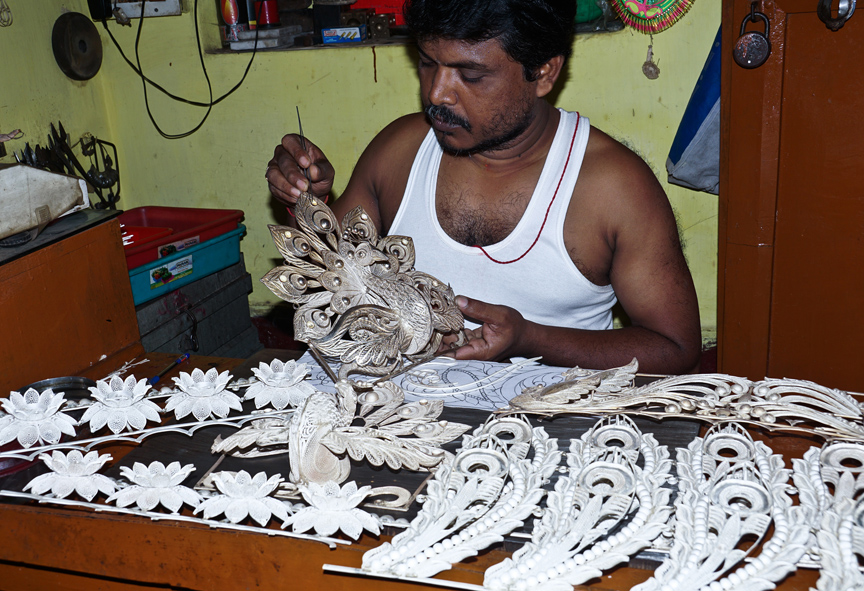
There is also healthy competition among local clubs and puja committees over putting up the best silver filigree backdrop. The more attractive the artwork, the more is the footfall at a pandal.
Umashankar Das, president of Ganga Mandir Puja Committee, says, “It is not only about the competition. It’s also about encouraging the exquisite art form of Tarakashi in the city. Though the city is famous for silver filigree, lack of resources and work opportunities have forced the young generation of the traditional craftsmen to choose other professions. Chandi medhas have been at least providing some periodic work to the craftsmen in the city, which is a good sign.”
The silver backdrops cost a lot, but the committees don’t mind shelling out money to make their Durga Puja a grand affair. According to an organiser, as much as 200 kilograms of silver may go into making one chandi medha. Committees don’t mind spending Rs 5,000 to Rs 6,000 on moulding one kilogram of silver.
There are quite a few prominent artisans who are in demand when it comes to designing these silver tableaux. There is also competition among organisers for roping in the best name to design the tableau long before the festival commences.
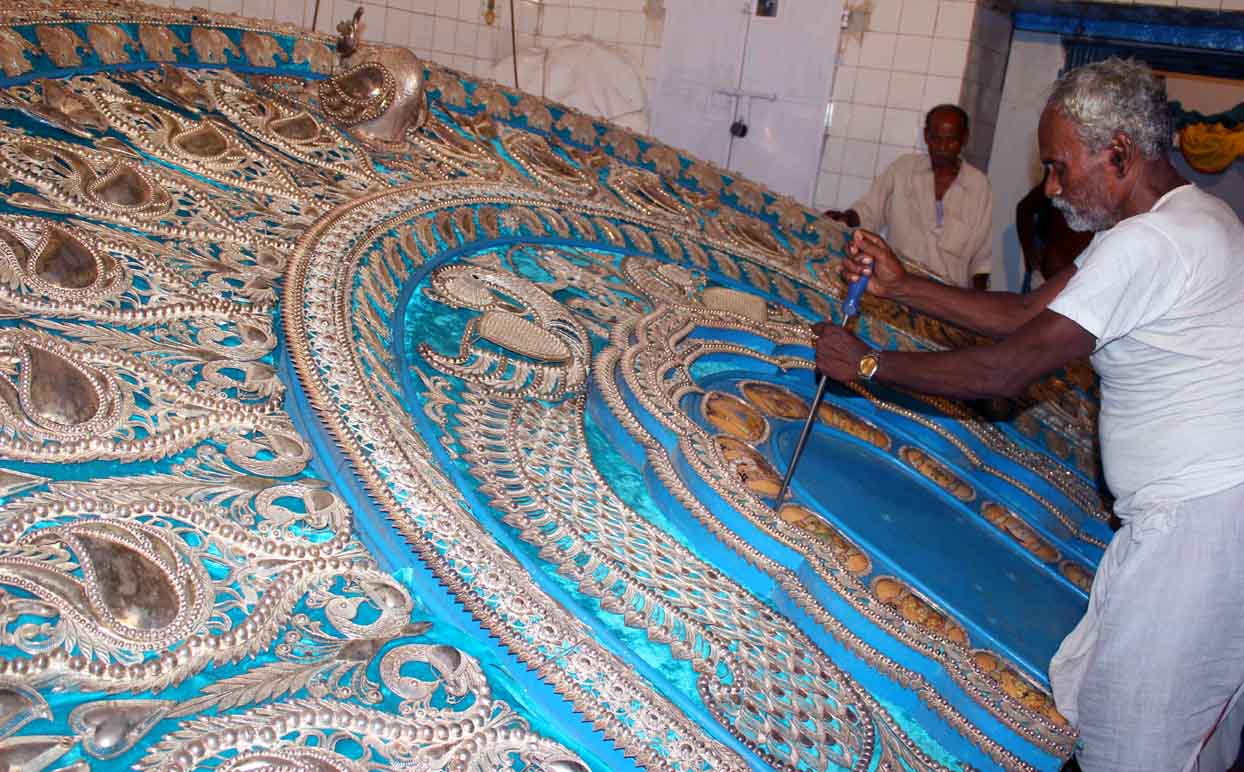
Names like Shashikant Singh, Sanatan Dash, Bhagaban Dash, Rabindra Kumar Dash and Ranjan Kumar Panda are already busy giving finishing touches to tableaux. Last year, as many as 25 Durga Pujas in Cuttack had chandi medhas, with their weight varying between 100 kg and 500 kg. This year, there are two additions, with Ganga Mandir and Chhatra Bazars puja committees also going for silver backdrops.
Interestingly, the silver filigree backdrop for Durga idols came into fashion in 1956. The trend was introduced by the Choudhury Bazar Durga Puja with its chandi medha weighing 250 kg. Later, the trend was picked up first by the Sheikh Bazar Puja Committee, which came up with a 350 kg chandi medha in 1991. Stiff competition over the “best silver filigree work” has since pushed puja committees in Chandni Chowk, Alisha Bazar, Chauliaganj, Badambadi, Kazi Bazar, Balu Bazar, Tulasipur-Bauri Sahi, Nayasarak, Machua Bazar, Firingi Bazar, Badambadi, Sikharpur and other places to come with giant chandi medhas.
Prafulla Prusti, a silver filigree artisan from Arundoya Nagar, Cuttack, says, “The rise in demand for silver tableaux in the city is a good sign for artisans like us. Apart from crafting new tableaux, we also do maintenance work on tableaux. Once the puja is over, the tableau is preserved by the organising committee. However, there is wear and tear because of which repair is needed from time to time. So, this is another way of getting some work. Moreover, the tableaux are made in parts, so many artisans are roped in for the assembling work every year. It’s good that craftsmen like us who take pride in our creativity are once again finding work. It is also a good sign for those who are new to the profession.”

“Apart from making silver tableaux, around 100 puja committees adorn the idols with silver ornaments. We make every ornament in silver from maang tikka to the payal of the Goddess. This year, Bapuji Club of Choudhury Bazar, Matha Sahi used 40 kg silver to make the medha for Lord Ganesha. I wish this club sets a trend of making giant chandi medha during Ganesha Puja every year. This will give us more work,” says Nandakishore Pal, a silver artisan who is busy giving final touches to the chandi medha at Chhatra Bazaar Durga Puja.
Silver filigree is dying in Cuttack
Cuttack now has only a handful of artisans who are actively involved in the business of silver filigree. The younger generation has not shown much interest in the profession mainly because of the declining business. Besides, there are no policies or schemes for the development of the filigree industry.
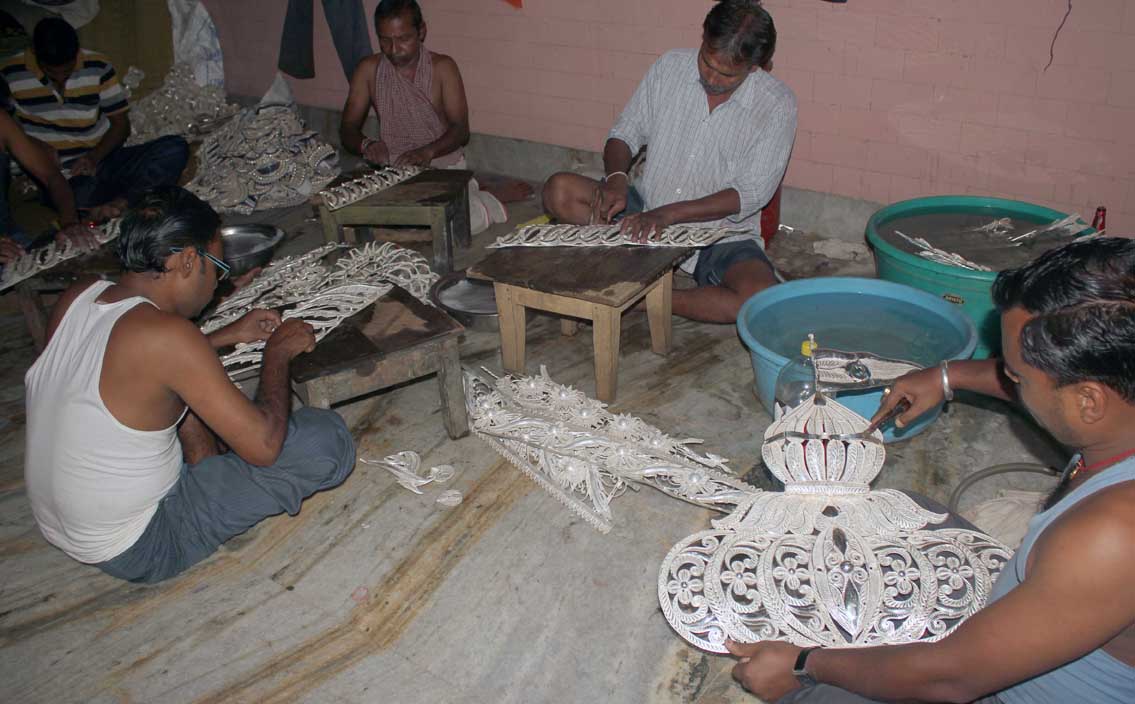
Pradip Kumar Prusti, an artisan from Cuttack, says, “The work is hard, it is intricate and delicate. It takes a lot of dedication and time, and the returns are not proportionate. Earlier, if silver cost Re 1, the cost of labour was also one rupee. But now silver costs Rs 40,000 per kg, while cost of labour is a meagre Rs 5,000-Rs7,000 per kg depending on the type of work. Moreover, an artisan can work only on two kilograms of silver in a month. Everyone wants a decent lifestyle and clearly continuing with this art form will not get you anywhere close to it. We are gradually losing artisans because of the decline in revenues. You can make more money working at a tea stall. I don’t expect my kids to join the trade as it would not meet their expectations.”
“It is disheartening to see the current state of the filigree industry. I have given all my life to this art form and one day it is going to be extinct. The art form has passed on from generation to generation, but now its future is in danger. There is a lot of money sanctioned every year in the name of art, craft, culture and heritage but we don’t see any of it. Students from abroad come here to learn silver filigree but our people have no interest in it,” he adds.
Filigree work is popular because of the intricate craftsmanship. Fine silver wires are made by melting the silver lumps through a tedious manual process and then different products are shaped from those fine wires.
Nirakar Das, a silver filigree artist from Mansinghpatna, Cuttack, who also is in-charge of crafting the chandi medha for the Chhatra Bazar Puja committee, says, “The main attraction of Cuttack Tarakasi is its fine spider web work. Beside jewellery, works of creative art portraying iconic monuments of the state, replica of Lord Jagannath, Hindu gods and goddesses, flora and fauna and, in recent years, a number of contemporary themes such as currency notes, chariots, rickshaws, bicycles, and so on are also seen in the market.”
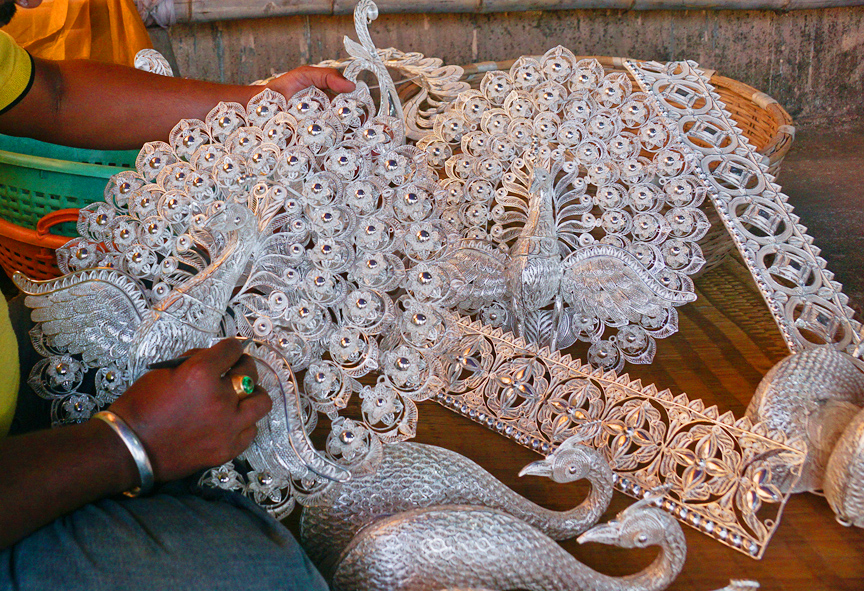
“The work is not easy. It requires a lot of effort as the process is very intricate and each stage requires adept movements. If you go wrong once, the entire effort goes in vain. Artisans who are mostly goldsmiths work with 90 per cent silver alloy. A machine is used to create thin silver wires from the rod. Wires are then shaped into a number of intricate designs, which are first drawn on paper. The thick silver wires are used as frames into which thin wires are embedded through the process of soldering. There are about 90 types of wire designs, of spirals and curls, creepers and jaalis, which the artisans use to create the outline,” explains Nirakar.
Naresh Kumar Sahoo, secretary of Firingi Bazar Durga Puja Committee, says, “Cuttack is also known as Silver City, so making chandi medha in Durga Puja is like keeping intact the glory of the city. It seems that puja committees are on a mission to revive the silver filigree industry in the city. Soon, a day will come when all the puja committees in the city will have chandi medhas and all the artisans will get more work to earn their livelihood.”
A bit of history
- Filigree, an ancient art of crafting jewellery with fine metal wires, is believed to have originated in Mesopotamia and Egypt and spread to Asia around 2500 BC. Indian and Greek filigree have similar patterns and processes to this day, pointing to their common influence.
- According to historians, there is every possibility that filigree work reached Cuttack from Persia via Indonesia around 500 years ago. Their view is based on the similar workmanship seen in Cuttack and Indonesia.
- It was during the Mughal era that the craft received royal patronage in Cuttack.
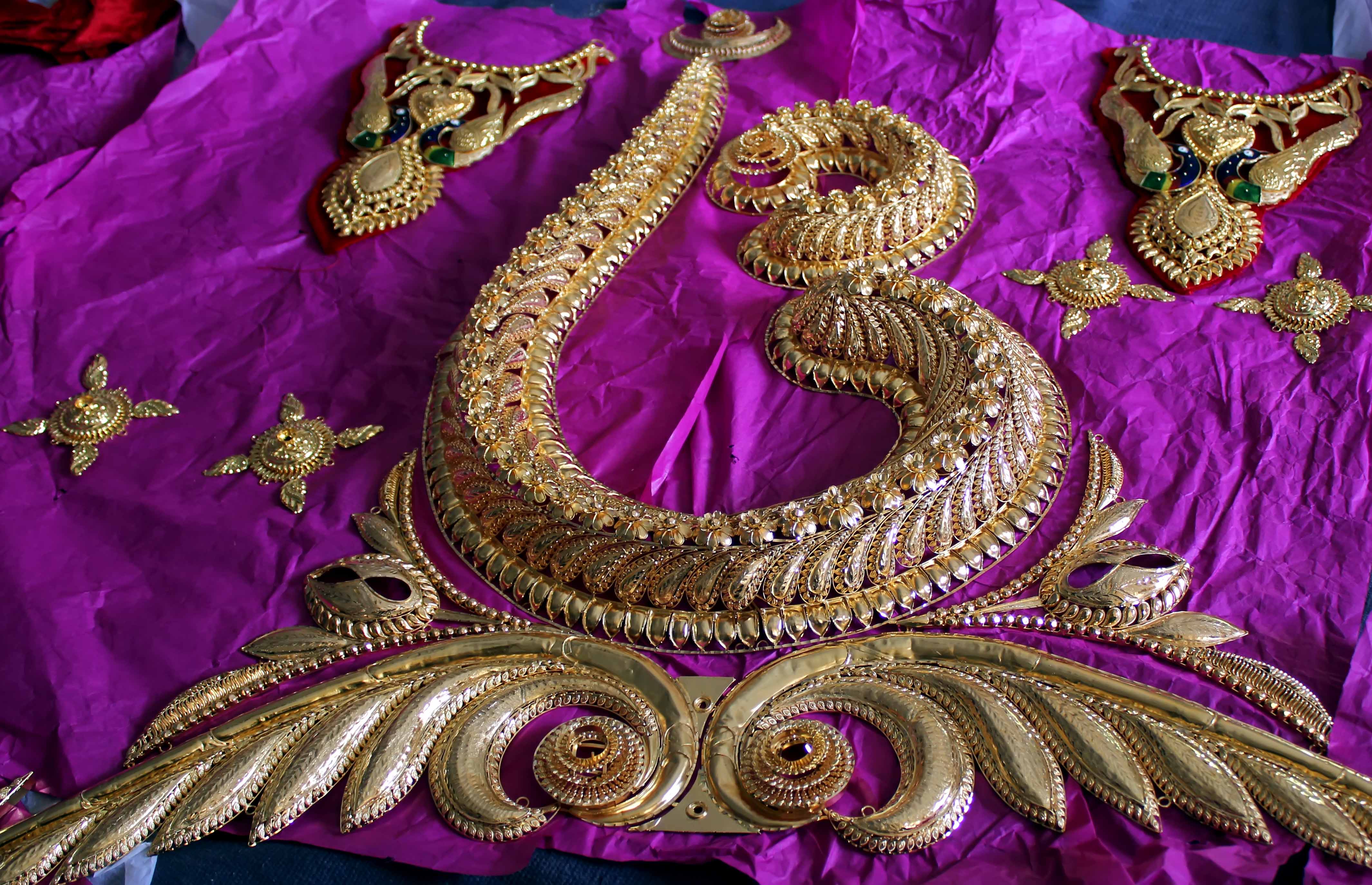
Difficult times
- Tarakashi or silver filigree work of Cuttack has gained recognition in India and abroad. Visitors to the city make sure to buy filigree items that have given Cuttack the name of ‘Silver City.’
- Filigree has flourished for centuries in the 1,000-year-old city. Filigree products like ornaments, jewellery, idols of deities, and gift items have a lucrative export market.
- There are about 1,000 traditional filigree craftsmen in Cuttack. However, they now get work only periodically. This has put the industry in danger.
- Other factors such as competition from Kolkata, which produces coarse but affordable silver filigree items, lack of interest among the new generation because of the labour-intensive and time-consuming nature of the work, high cost of raw material, poor returns and absence of a strong community based leadership have also adversely affected the industry.
SOYONG, OP

